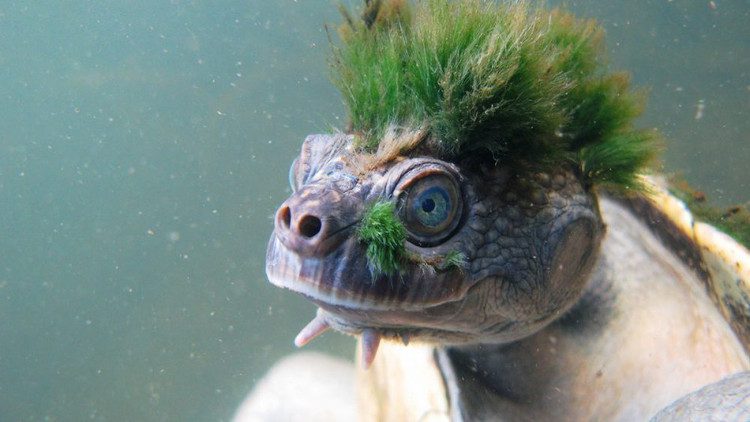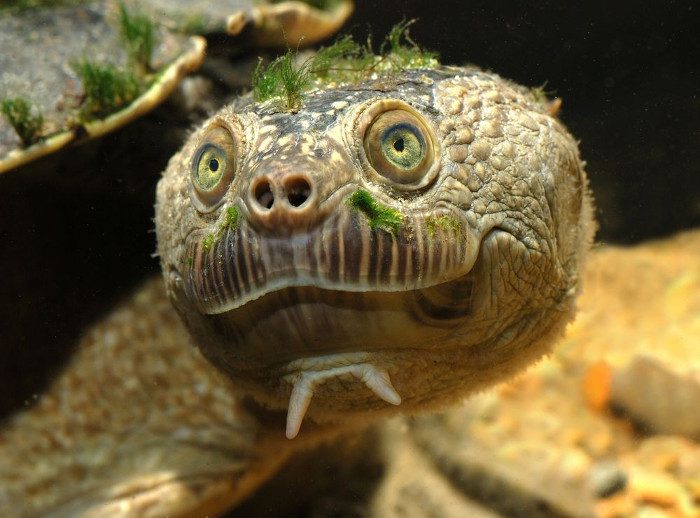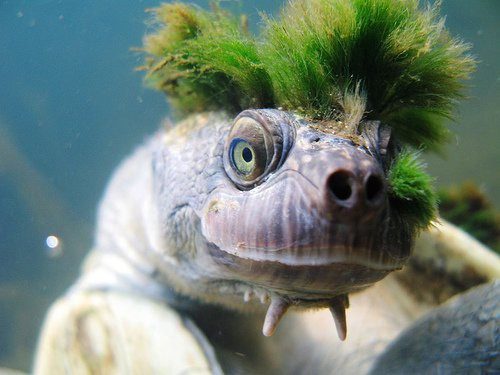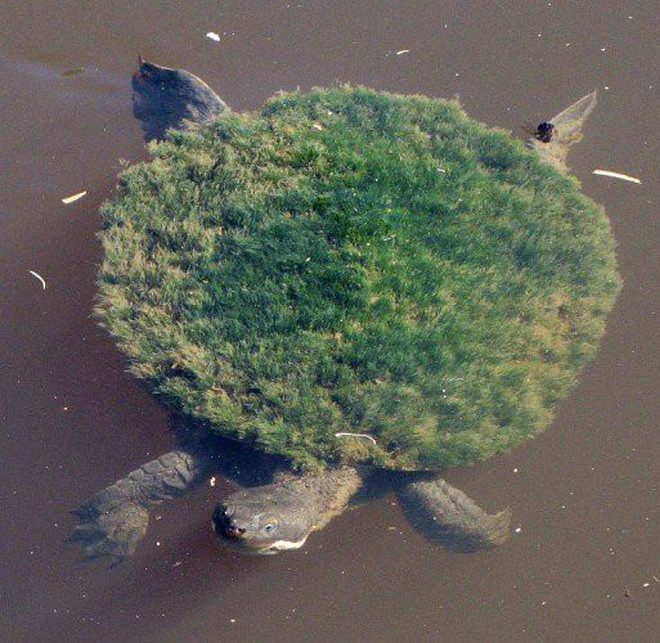The Turtle with Green “Hair”: Is It a Natural Beauty or Cosmetic Surgery? Additionally, you will learn about a unique turtle species with an unusually tragic fate.
Recently, the spotlight has been on Mark Zuckerberg as he testified before the U.S. Senate. However, this does not make the turtle in the photo below any less captivating to internet users.
Just look at it! With its punk-style beak-like head and bright green color, doesn’t it resemble a tough street kid from half a century ago?

Actually, that’s not green hair on its head—it’s just algae.
This is indeed just a turtle, but not the kind you see every day. The reason it stands out is not because of the green “hair”—which is actually just algae—but because it is on the brink of extinction.
This turtle belongs to the Mary River turtle species, found in the river of the same name in Australia. It measures about 40 cm long and has two unusually large nostrils. Occasionally, some turtles have algae growing on their heads, creating funky hairstyles like the one in the picture.
Mary River turtle (Elusor macrurus) lives in the river of the same name in Queensland, Australia. It primarily feeds on aquatic plants but occasionally consumes seeds, fruits, and insect larvae. This species is uniquely shaped due to the green algae growing on its head and body, which helps it camouflage from underwater predators. It also has long fleshy spikes known as barbels protruding from its chin, allowing it to sense its surroundings.
Tragically, this species is among those classified as critically endangered. Recently, the Zoological Society of London (ZSL) ranked the Mary River turtle 29th on the list of the world’s most endangered reptiles. This list is abbreviated as Edge.
“Reptiles often do not receive the proper attention from conservationists, unlike birds and mammals,” said Rikki Gumbs, the coordinator of the list.
“The Edge list aims to highlight their uniqueness and vulnerability.”

Mary River turtle.
Mary River Turtle – A Species with a Tragic Fate
Unfortunately, the fate of the Mary River turtle is as “unique” as its appearance. During the 1960s and 1970s, they were highly sought after as pets. The distribution of the Mary River turtle in the wild remained a mystery to scientists until it was officially described as a species in 1994.
At that time, up to 15,000 juvenile turtles were sold annually to pet shops across Australia. Humans raided their nests in the wild. And thus, we have pushed the Mary River turtle to the edge of extinction.
Currently, conservationists are making significant efforts to preserve this turtle species to maintain biodiversity in the area.
“Like tigers, rhinos, or elephants, saving this unique species is extremely important, especially since they have been overlooked for a long time.”
“Many of the reptiles on the list have ancient origins, with lineages that can be traced back to the age of dinosaurs.”
The Mary River turtle itself has very ancient origins, even among the oldest on Earth. It is known to have diverged from modern turtle species about 40 million years ago and continues to exist today. For perspective, humans separated from chimpanzees only about 10 million years ago.

The Mary River turtle has very ancient origins, possibly the oldest on Earth.
It is unclear if its ancient lineage is the reason this turtle species possesses so many unique characteristics compared to other turtles.
Firstly, they have very long tails—up to 70% of the length of their shell. Under their chin, they have two protrusions like fingers, which help them sense the water around them.
Remarkably, they have a breathing method unlike any other creature on Earth: they can… breathe through their cloaca.
Specifically, this turtle can breathe through its nose like regular turtles, but its cloaca has a structure similar to gills. This structure allows them to absorb oxygen in the water for up to three days.
The Mary River turtle is also very unique. No other turtle species is its close relative. “This is the only living species in its genus. The ancestors of the Mary River turtle are believed to have diverged from all other living turtle lineages over 18 million years ago, several million years before the ancestors of humans separated from orangutans.”
The “Punk Turtle” Photo That May Save the Species
In fact, the image of the “punk turtle” with green “hair” is not a new phenomenon. In 2009, the local Australian government planned to construct a dam, a project that could harm this already endangered turtle species.

In the last 20 years, they have been threatened by wildlife, water pollution…
Then a photographer captured a series of images of the “green-haired turtle.” The images spread rapidly, becoming the “mascot” for conservation efforts. Public outcry ensued, and the project was quickly canceled.
However, this turtle species is still not safe. In the last 20 years, they have been threatened by wildlife, water pollution, and livestock grazing along the river. It is estimated that the total population of turtles has decreased by up to 95% compared to their historical numbers.
“If we lose this turtle species, we will not have any creatures like it left on Earth. And that is entirely our fault,” Gumbs stated.


















































